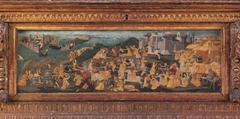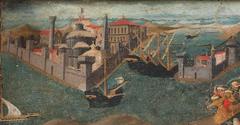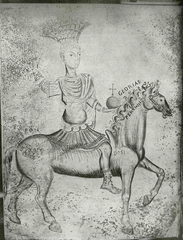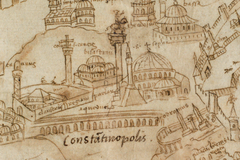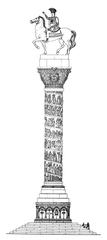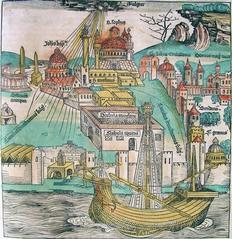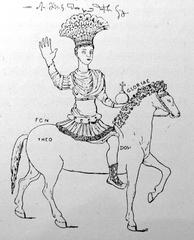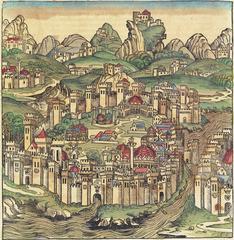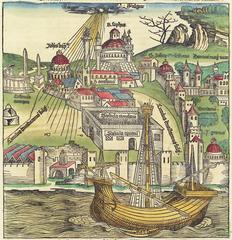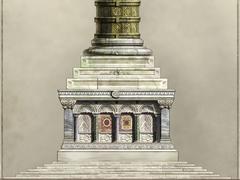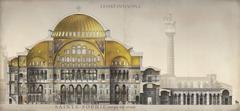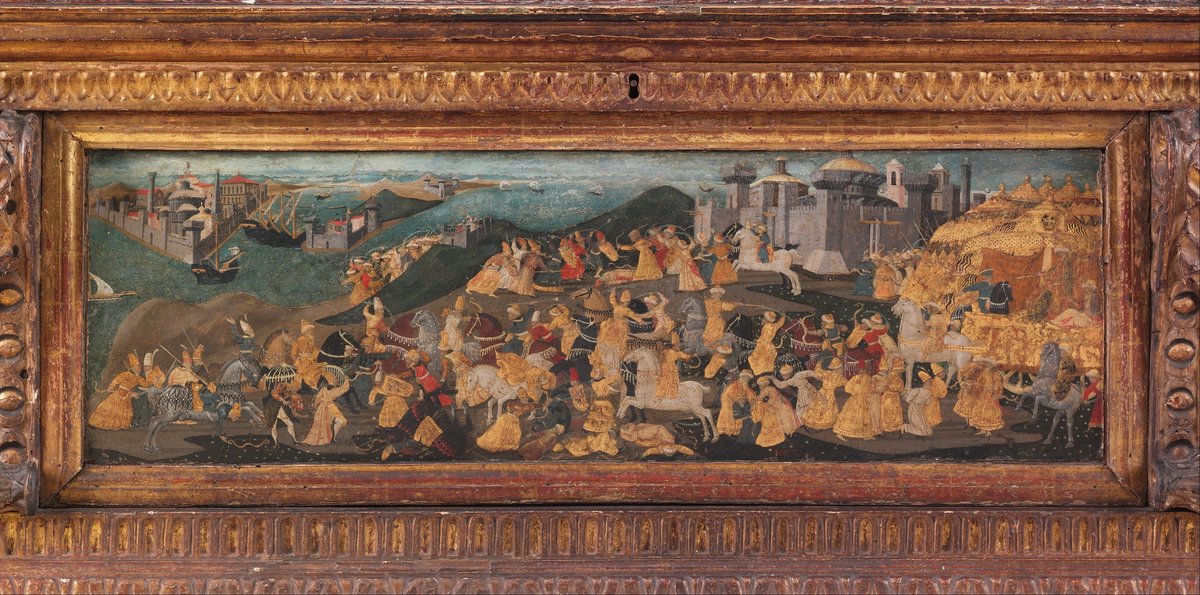
Column of Justinian Visiting Hours, Tickets, and Historical Significance in Istanbul
Date: 14/06/2025
Introduction
Situated in the heart of Istanbul’s Sultanahmet district, the Column of Justinian once towered over the Byzantine capital, standing as a symbol of imperial power and Christian dominion. Erected in 543 CE during the reign of Emperor Justinian I, this monumental structure became an enduring emblem of the city’s grandeur and resilience. Though the column itself no longer survives above ground, its historical footprint, surrounded by some of Istanbul’s most iconic landmarks, offers a fascinating window into the city’s layered past.
This comprehensive guide details the history of the Column of Justinian, practical information for travelers—including visiting hours and ticketing for nearby attractions—accessibility, travel tips, and recommendations for exploring related sites in Istanbul. Whether you are a history enthusiast or a curious visitor, understanding the column’s significance will enrich your exploration of Istanbul’s Byzantine heritage.
For in-depth research and planning, consult authoritative resources such as the Hagia Sophia Museum and Istanbul Byzantine Ruins and Sites.
Table of Contents
- Historical Overview
- The Column’s Features and Symbolism
- Current Site and Accessibility
- Visiting Hours and Ticket Information
- Nearby Attractions
- Travel Tips and Visitor Experience
- Frequently Asked Questions (FAQ)
- Visuals and Media
- Conclusion and Resources
Historical Overview
The Column of Justinian was commissioned by Emperor Justinian I in 543 CE to commemorate his military victories and affirm his divine right to rule. Rising approximately 50 meters high and crowned with a gilded bronze statue of Justinian on horseback, the column was a focal point of the Augustaeum, the ceremonial square adjacent to the Hagia Sophia and the imperial palace. The monument embodied the fusion of Roman architectural traditions and Byzantine religious ideology, serving as both a political statement and a spiritual symbol for nearly a millennium.
Byzantine chroniclers and visitors marveled at the column’s scale and the emperor’s commanding figure, which faced east toward the Persian frontier. The orb held by Justinian’s statue was believed to possess mystical powers, and its fall in the early 15th century was viewed as a harbinger of change. The column ultimately collapsed in 1509 due to a major earthquake, and its remnants were repurposed or lost during the Ottoman era.
The Column’s Features and Symbolism
- Materials and Construction: The shaft was built from Proconnesian marble, inspired by earlier Roman triumphal columns but adapted to Byzantine aesthetics.
- Statue of Justinian: The bronze statue depicted the emperor in military dress, holding a globus cruciger (a globe surmounted by a cross), symbolizing Christian dominion.
- Base and Reliefs: The pedestal, now lost, reportedly featured elaborate reliefs celebrating Justinian’s achievements and the spiritual authority of the empire.
The column’s prominent placement highlighted the central role of the emperor in both civic and religious life, linking the secular and sacred spaces of the Byzantine capital. Its memory endures through literature, engravings, and fragments preserved in museum collections. (Lions in the Piazza: Byzantine Architecture)
Current Site and Accessibility
Today, the exact location of the Column of Justinian is believed to be near the intersection of Divan Yolu and Alemdar Caddesi, just outside the Hagia Sophia and Sultanahmet Square. While the column itself no longer stands, the area is rich in historical markers and interpretive plaques that commemorate its former presence.
- Public Access: The site is an open urban space, fully accessible to the public at all times without the need for an entrance ticket.
- Getting There: Easily reachable by public transport, the Sultanahmet tram stop (T1 line) is within a short walk, connecting visitors to the city’s major tourist hubs.
Visiting Hours and Ticket Information
- Column of Justinian Site: Open 24/7 as a public space; no ticket required.
- Nearby Attractions:
- Hagia Sophia: Open daily 9:00 AM–7:00 PM (last entry 6:00 PM); ticket required.
- Basilica Cistern: Open daily 9:00 AM–5:30 PM; ticket required.
- Topkapı Palace: Open daily 9:00 AM–6:00 PM; ticket required.
- Hippodrome: Open public square; no ticket or time restrictions.
Tickets for major sites can be booked online or purchased at the entrance. Guided walking tours are available and often bundle several attractions for convenience.
Nearby Attractions
The Column of Justinian’s site sits amid Istanbul’s most significant historical monuments:
- Hagia Sophia: An architectural masterpiece and symbol of Byzantine and Ottoman legacy. (Hagia Sophia Museum)
- Basilica Cistern: A vast underground reservoir from Justinian’s era.
- Hippodrome of Constantinople: Ancient chariot-racing stadium dotted with obelisks and columns.
- Topkapı Palace: Home to Ottoman sultans and treasures, with museum displays including Byzantine artifacts.
Each site offers its own unique insight into the city’s transformation from Byzantium to Istanbul.
Travel Tips and Visitor Experience
- Best Times to Visit: Spring and autumn offer the most pleasant weather. Early mornings or late afternoons are ideal to avoid crowds.
- Accessibility: The area is mostly flat and wheelchair-friendly, though some cobblestones remain. Major attractions provide accessible entrances.
- Guided Tours: Many reputable operators offer Byzantine-focused tours, available in multiple languages.
- Amenities: Sultanahmet is well-served with public restrooms, cafes, shops, and free Wi-Fi.
- Safety: The district is tourist-friendly and policed, but standard precautions against pickpocketing apply.
Frequently Asked Questions (FAQ)
Q: Can I see the Column of Justinian today?
A: No, the column and statue no longer exist, but the site is marked and accessible. Fragments are preserved in museum collections.
Q: Is there an entrance fee to visit the column’s site?
A: No, the area is open to the public free of charge.
Q: Are guided tours available?
A: Yes, many walking tours include the column site and key Byzantine monuments.
Q: Is the area accessible for people with mobility challenges?
A: Yes, the site and most nearby attractions are accessible.
Q: What other Byzantine columns can I see in Istanbul?
A: The Column of Constantine (Çemberlitaş), Column of Marcian, and the Goths’ Column remain standing and can be visited.
Visuals and Media
To enhance your visit, explore artistic reconstructions and historical illustrations of the Column of Justinian in museums and online resources. Virtual tours and interactive maps—often available through travel apps or official museum sites—offer immersive experiences that help visualize the monument’s original splendor. Use alt tags for images such as “Reconstruction of the Column of Justinian in the Augustaeum” and “Site of the Column of Justinian near Hagia Sophia.”
Conclusion
Although the Column of Justinian no longer graces Istanbul’s skyline, its historical significance and symbolic legacy remain vibrant threads in the city’s cultural tapestry. Exploring the site and surrounding landmarks offers a tangible connection to the Byzantine era and the enduring story of imperial Constantinople. With abundant visitor amenities, accessible public spaces, and expert-guided tours, Sultanahmet is a must-visit for anyone eager to immerse themselves in Istanbul’s rich past.
For optimal planning, consult digital resources, download the Audiala app for audio guides and updates, and stay informed through official tourism portals.
References and Official Sources
- Istanbul Byzantine Ruins and Sites
- Lions in the Piazza: Byzantine Architecture
- Hagia Sophia Museum
- Istanbul Tourist Pass
- Istanbul Archaeological Museums
- Basilica Cistern Visitor Guide
- Headout Basilica Cistern Tips
- Visit Turkey
For more travel tips and in-depth guides to Istanbul’s historical sites, download the Audiala app and follow us on social media. Embrace Istanbul’s living history—plan your visit to the Column of Justinian and its remarkable surroundings today.
